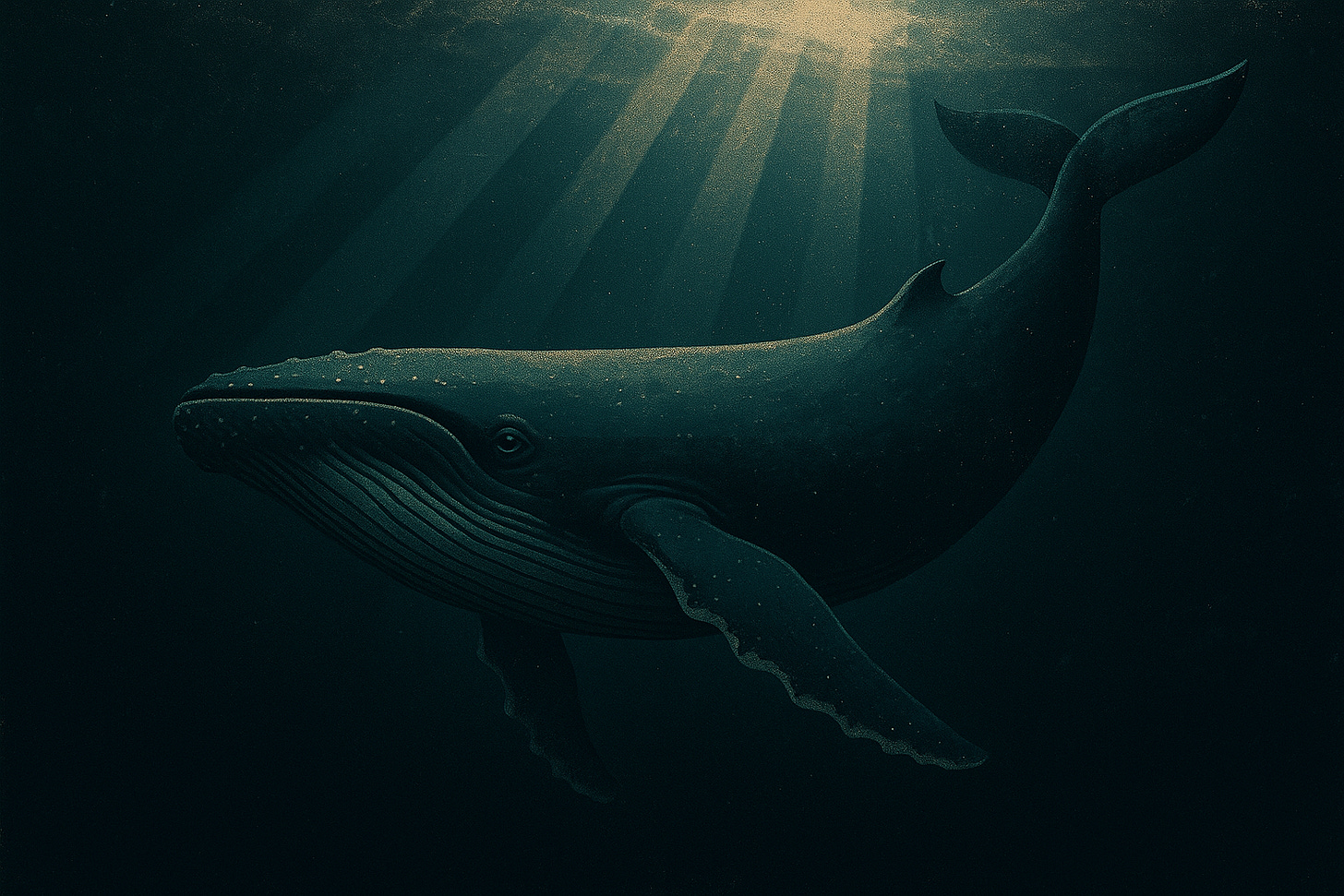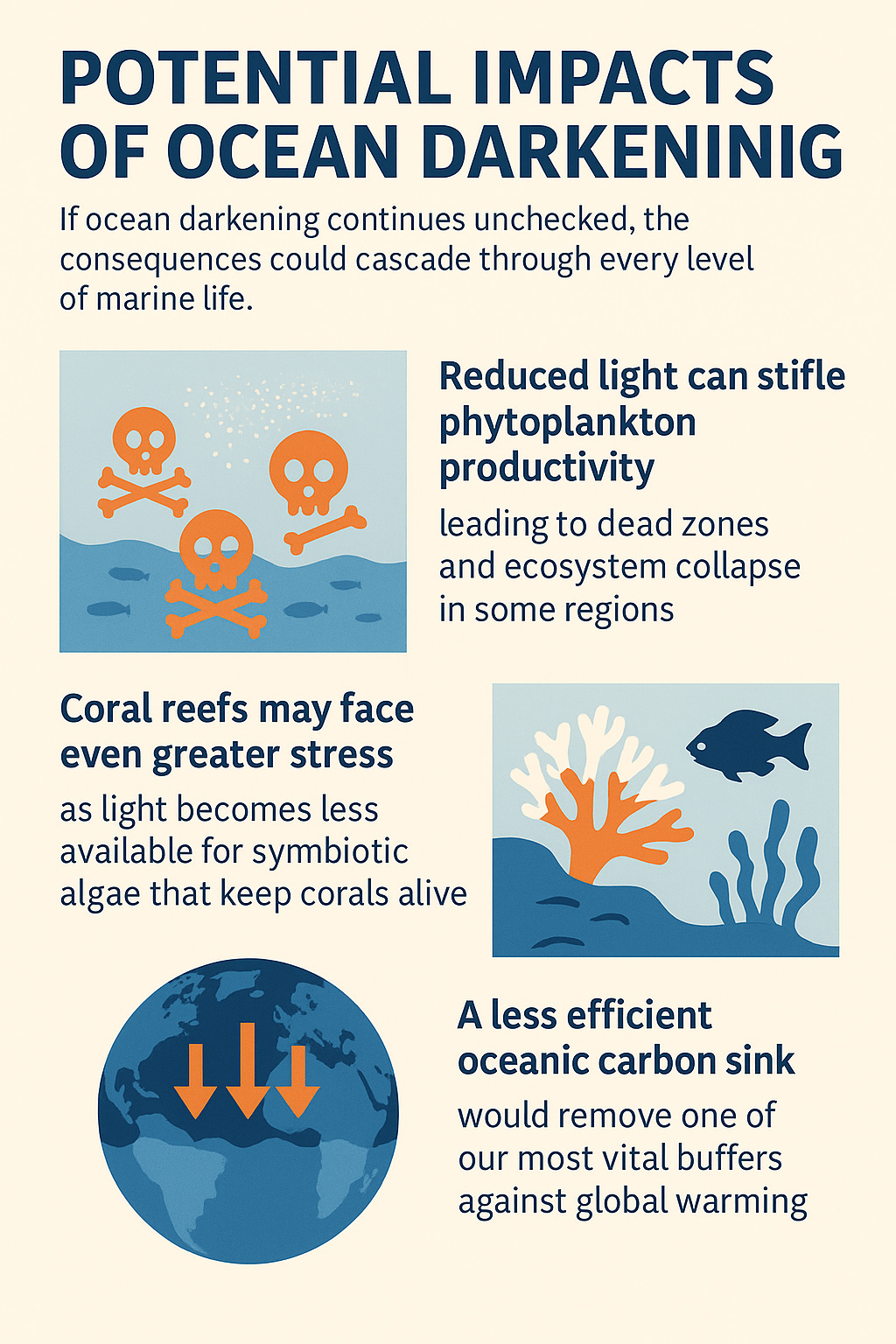Ocean Darkening: How Light Loss Threatens Marine Life and Climate Stability
Sunlight is vanishing from the ocean depths, disrupting phytoplankton, coral reproduction and the planet’s ability to stay cool. So why is no one sounding the alarm?
Imagine walking through a city park and seeing that the sky had dimmed. Sunlight no longer filtered through the trees. Everyday life looked darker. You might check the news. You might worry something was wrong. Most importantly, you could see the change for yourself.
That is the difference. When changes happen on land, we see them. We photograph them. We ask questions.
In the ocean, none of that happens. The surface can look the same, even as the water beneath grows darker and darker. It is out of sight and beyond the reach of most people’s daily lives.
In the ocean things happen quietly. Invisibly. No one talks about it.
A new study from the University of Plymouth has confirmed that over the last 20 years, a fifth of the global ocean has become darker. The findings, published this week in Global Change Biology, reveal that 21% of ocean surface waters have experienced significant reductions in light penetration since 2003. In some areas, the light has declined by more than 100 metres.
The process is called ocean darkening. It refers to changes in the uppermost layer of the sea that reduce how deeply sunlight can travel. That light is not just about visibility. It is the lifeblood of marine ecosystems.
A Shift in the Planet's Pulse
Light fuels the ocean's biological engine. It triggers photosynthesis in phytoplankton, the microscopic plants that produce oxygen and form the base of the marine food web. It guides species that migrate vertically through the water column. It governs reproduction, feeding and survival for countless creatures.
When light vanishes, so does stability.
Over the past 20 years, sunlight is reaching less deeply into many parts of the ocean. In more than 9% of the ocean, an area about the size of Africa, sunlight now fades out 50 metres (164 feet) shallower than it used to. In another 2.6%, the light is blocked more than 100 metres (328 feet) higher up than before.
This means large regions are significantly darker. For marine animals and plants that depend on light to survive, feed or reproduce, that’s a major problem. It signals a dramatic shift in the way ocean ecosystems function.
What's Causing It?
Scientists believe multiple factors are at play:
Algal bloom dynamics: Algae are tiny plant-like organisms that live in the ocean. Sometimes, they grow incredibly quickly and form huge groups called blooms. These blooms can block sunlight from reaching deeper into the water. Without sunlight, some marine plants and animals struggle to survive. Big blooms can also use up oxygen in the water, which makes it hard for fish and other sea creatures to breathe. This puts the whole ecosystem at risk.
Warming waters: Climate change is making the surface of the ocean warmer. When this happens, the water forms layers that do not mix as easily. It’s like putting oil on top of water, each layer stays separate. Because they don’t mix, dirt, plankton and pollution stay near the surface. These can all block sunlight from reaching the deeper parts. Warmer water also causes more chaos in the ocean. Fish might move away. Coral might die. The whole food chain starts to shift.
Artificial light pollution: As cities grow near the coast and more ships and offshore platforms appear, artificial light is spreading into the ocean. That light confuses animals that depend on natural cycles of light and dark. Some species use moonlight to know when to eat, move, or reproduce. When artificial light takes over, these patterns break down.
These changes are not cosmetic. They are physical. They affect the biology of the ocean.
Why It Matters
Dr Thomas Davies, associate professor of marine conservation at the University of Plymouth, put it plainly: "Our findings represent genuine cause for concern."
Many marine animals depend on natural light to survive and thrive. Coral reefs, for example, release their eggs and sperm using the light of the full moon. Some animals rise and fall in the water every day depending on sunlight. This is the biggest daily movement of animals on Earth. When it’s darker, hunting and hiding become harder or easier for different species. That changes who eats who in the ocean.
When the ocean gets darker, all of these patterns can be thrown off.
Prof Tim Smyth, from the Plymouth Marine Laboratory, warns that ocean darkening could force some species closer to the surface in search of light. That will intensify competition for food and space. It could rewire marine food chains.
The Implications Are Planetary
Phytoplankton, which depend on sunlight, produce at least half of the oxygen we breathe. They are also the base of the marine food web and critical to absorbing carbon dioxide from the atmosphere.
When the ocean darkens, it threatens these systems. With less sunlight, phytoplankton produce less oxygen. That weakens one of Earth’s most important life support systems. A less productive phytoplankton population also means fewer fish and less food for everything up the chain, including people.
The ocean is also the planet’s largest carbon sink. It has absorbed about a quarter of all the carbon dioxide humans have emitted since the industrial revolution. That helps slow global warming. Darker, more layered oceans are worse at this. The surface traps more heat, and less carbon moves down into the deep sea.
This is not just a problem for marine life. It affects the air we breathe, the food we eat, and the planet’s ability to stay cool.
The Slow Dimming of the Sea
Ocean change is hard to visualise. It unfolds out of sight and often out of mind. Ocean darkening is not a disaster headline. It is a slow erosion of balance.
But.
This makes it no less urgent.
We are witnessing the slow dimming of the sea.
If ocean darkening continues unchecked, the consequences could cascade through every level of marine life:
Reduced light can stifle phytoplankton productivity, leading to dead zones and ecosystem collapse in some regions.
Coral reefs, already vulnerable to bleaching, may face even greater stress as light becomes less available for symbiotic algae that keep corals alive. Fish populations could crash if key reproductive and migratory behaviours are disrupted.
A less efficient oceanic carbon sink would remove one of our most vital buffers against global warming.
Imagine dropping a torch into a deep pond. At first, you can see it shining below the surface. But slowly, murky water rises. The beam grows faint. Then it disappears. That is what is happening in our oceans. We are losing light. And with it, we may lose life.
What Needs to Happen
This is not just a scientific observation. It is a wake-up call. Ocean darkening must be monitored more closely, incorporated into climate models, and considered in conservation strategies.
Policymakers, environmental NGOs and funders need to prioritise ocean visibility in every sense of the word. The sea cannot remain a blind spot.
And for the rest of us? Read the research. Talk about it. Shine a light on this issue before it slips further into obscurity.
The ocean does not just reflect our future. It regulates it.





As an avid SCUBA diver (55 years) and ocean farmer (30 years) I have certainly noticed the reduction in seawater visibilty over that time. it has been very significant in the FL Keys where I operate, and elsewhere in the Caribbean based on repots I get from travellers.
I wonder if blooms of phytoplankton such as Coccolithipore, visible from space as milky colored water, are helping increase the carbon sequestration we see with marine life in general. These tiny plants draw CO2 and Calcium together to produce calcium carbonate skeletons that can sink into the ocean depths. Is it possible to quantify the effect?